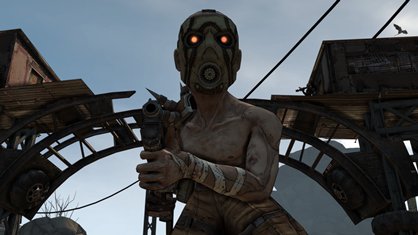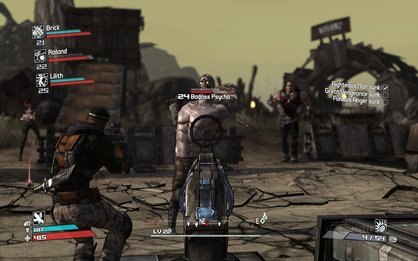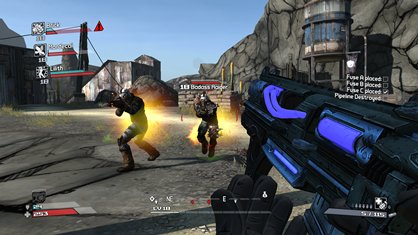Borderlands – hands-on
The other main aspect of the game is growth. There are four main character classes, although we were only able to play as Heavy, Siren, and Hunter. Within each of these classes there are specific ‘Focus’ abilities. For example, the Siren can ‘Phase Walk’, which means she can turn invisible for a brief period of time and move quicker than other characters.

Then you can develop your character within these classes, boosting abilities in a similar way to Fallout 3. The Heavy class has a Rage ability that at a very basic level will boost your strength and shielding. Here you lose your guns and go in physically with Condemned 2-style FPS uppercuts. However, leveling Rage unlocks extra ways to play. For example, one boost will see enemies spill cash instead of blood. There are also the usual health, armour and combat developments to boost accuracy, health and protection. And just like any RPG, experience points govern leveling, while extra weapons and items can be found that have been dropped by dead enemies or bought with cash. This is the core RPG element of Borderlands that plays like all dungeon crawlers from Baldur’s Gate to Marvel Ultimate Alliance to Fallout 3.
“I find it generates the same compulsion I had from playing Diablo all those years ago!” says Pritchard, adding: “It’s got that same need to trawl for loot, cash, items and leveling that I loved about those games.” This was evident when we switched from single-player to co-op. Borderlands supports drop-in multiplayer, so you can begin a campaign on your own and then have friends join in as you play – just like an RPG. With four of you charging around looking for the kills, trying to scoop the loot and competing for items dropped by the recently bloodied mutant midget with the Mohawk, Borderlands really does begin to shed its FPS looks and play like a bona fide dungeon crawler.

The downside is that the game quickly becomes chaotic as the screen becomes packed with enemies large and small, and you’ve got three buddies taking up your line of sight. Add in explosive attacks, special abilities that light up the screen in a whoosh of blue lightning and Borderlands really turns up the heat.
Of course, teamwork settles the game down. The classes come into their own in co-op, with the Hunter sitting back sniping from distance, the Heavy up front pounding cash out of a giant spider, and the Siren flitting in and out picking off enemies unawares. Now things are less cluttered - there’s a focus and the game begins to show off its subtle ideas. For example, when your health depletes you don’t just sit there waiting to be healed by a teammate - the screen flashes ‘SECOND CHANCE!’ and you get 30 seconds to mop up some enemies and boost your health marginally for every kill. You can’t move from the spot, but you can spin around and shoot. It’s a neat touch that works best in single-player – as without a teammate to save you it can prevent any frustrating deaths at the hands of a giant rat-spider-thing, forcing a respawn miles from your quest (Fallout 3 take note).
The melding of a shooter with RPG elements is topped off by a visual direction that distances Borderlands from like games. The hand-drawn art style is colourful and dynamic; it places the world of Pandora miles away from shooters like Fallout 3. Before the shift in visual style, Borderlands was looking increasingly like a ‘me-too’ title, a game aping Fallout 3 while taking none of Bethesda’s risks. The new look at once makes Borderlands fresher than most other shooters.

“A bunch of guys came to me and said: ‘We’ve been working on a new look for the game using our original design sketches.’ When I saw it I was wowed, it reminded me of working on Duke Nukem. It was kind of like ‘F**k it, let’s do it’!” We’re glad they did. The result is a beautiful, original-looking game that’s truly representative of the gameplay, where an explosion of colour and crazy creature design, chaotic combat and competition for loot replaces greys and browns. In many ways it’s the visual style of an RPG, but it’s an FPS.
Weekly digests, tales from the communities you love, and more
Aug 26, 2009

Imagine FX and Creative Bloq editor Ian Dean is an expert on all things digital arts. Formerly the editor of Official PlayStation Magazine, PLAY Magazine, 3D World, XMB, X360, and PlayStation World, he’s no stranger to gaming, either. He’ll happily debate you for hours over the virtues of Days Gone, then settle the argument on the pitch over a game of PES (pausing frequently while he cooks a roast dinner in the background). Just don’t call it eFootball, or it might bring tears to his eyes for the ISS glory days on PS1.


